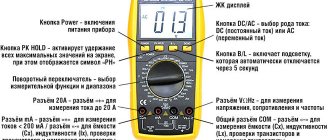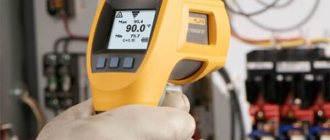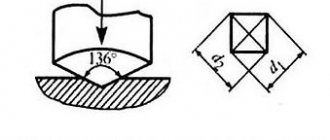Carrying out measurements using medical dynamometers: wrist and backbone
Measurement of force and torque in humans is carried out using dynamometers.
But not ordinary ones, which are used in industry, but special ones - medical ones. Medical dynamometers include a wrist dynamometer, also called a hand dynamometer, and a backbone dynamometer. In this article we will tell you how measurements are carried out using these devices. So let's start with the wrist dynamometer. This device is intended to determine the compressive force of the muscles that flex the fingers of both human hands, as well as to diagnose the condition and function of the hands of both healthy people and those recovering from injuries.
The hand dynamometer is used by doctors who engage in physical therapy; in addition, the dynamometer is used in law enforcement agencies, the armed forces and the Ministry of Emergency Situations. Strength measuring devices are indispensable for the training of professional athletes.
As an example of a hand dynamometer, we can cite such devices as: mechanical DC and electronic DMER.
Hand dynamometer DC.
Taking isometric strength measurements using a dynamometer does not require much time, and the measurement process does not tire the subject. To obtain accurate absolute results, it is necessary for the patient to maintain a certain body position and the angle of individual joints.
Let the person being examined extend his arm with the hand dynamometer and move it to the side perpendicular to the body. The free hand, at the same time, should be relaxed and lowered down. After which, on command, he will have to squeeze the wrist dynamometer as hard as he can.
The dynamometer measurement can be taken alternately with both hands several times, with the best result for each hand being selected.
Drawing conclusions based on the absolute results of the measurements can only be made dynamically, when the previous results were recorded in a special diary.
Otherwise, since the results of measurements made using a dynamometer are influenced by factors such as age, sex of the subject, as well as height and weight, more objective indicators should be used. The most objective indicator of strength will be the so-called relative magnitude of muscle strength.
This is due, in addition to the listed factors, to the fact that during training, the increase in absolute strength indicators is closely related to the growth of a person’s muscle mass, and, as a consequence, to his weight.
To determine the relative hand strength, you need to multiply the absolute readings in kilograms obtained by measuring with a hand-held dynamometer by 100 and divide by the athlete’s body weight. For men who do not engage in sports, this figure should be 60-70, and for women 45-50.
Deadlift dynamometry, carried out using a deadlift dynamometer, is, one might say, a comprehensive measurement of the strength qualities of an athlete, since almost all major muscles are involved in such a study.
The deadlift exercise using a dynamometer should be used in all dispensary-type sports and recreational institutions. As an example of a deadlift dynamometer, we can cite the DS-200 and DS-500.
Dynamometer Stanovoy DS-200
Deadlift dynamometry involves the use of a deadlift dynamometer - a device that looks like a regular foot expander, which consists of a handle, a footrest placed under your feet, a cable and a measuring device with a sensor and a reading device. The subject must pull the handle towards himself and up as hard as he can, while keeping his legs straight at the knees.
The relative value of the deadlift force is calculated in exactly the same way as in manual dynamometry, however, here the index values should be several times higher. For example:
If the index is less than 170, then the relative strength index is low.
- From 170 to 200 – below average.
- 200 – 230 – average.
- 230 – 260 – above average.
- If more than 260, then it is considered high.
An increase in relative strength indicators, both manual and deadlift, usually indicates an increase in muscle strength, and, consequently, an increase in muscle mass as a percentage.
Indications from such measurements are used in neurology when examining diseases that may be accompanied by muscle weakness, for example, myasthenia gravis, multiple sclerosis with limb weakness, as well as various consequences of stroke.
Separately, we should highlight a type of study called dynamography, in which indicators of the strength and speed of muscle contraction are recorded on a graph.
As the name suggests, the essence of this method is that the readings are recorded graphically over time (over time).
Often, dynamography is associated with any exercises or circumstances, the effectiveness of which needs to be measured.
In children, there are also average dynamometry indicators, which are considered to be the norm. Average values vary depending on the gender, height, and age category of the subject.
Measurements of right hand strength and backbone strength are usually carried out for children aged eight to 18 years in two stages, with a short break for rest.
Thus, the norms for indicators of right hand strength for boys are:
- From 13 to 18.5 kg – for ages 8-11 years.
- 21.6 – 37.6 kg – 12-15 years.
- 45.9 – 51 kg – 16-19 years.
For girls, the norm ranges from:
- 9.8 – 17.1 kg – for ages 8-11 years.
- 19.9 – 28.3 kg – 12-15 years.
- 31.3 – 33.8 kg – 16-19 years.
Concluding the article, let’s just say that dynamometry is an important element of anthropometry, which has found its application in physiology, sports medicine, and sports hygiene. Thanks to the indicators of absolute and relative strength, the degree of physical development of a person is assessed.
Source: //www.raznoves.ru/podderzhka/stati/provedenie-izmerenij-pri-pomoschi-medicinskih-dinamometrov-kistevogo-i-stanovogo/
Read also[edit | edit code]
- Functional movement abilities: mobility and stability
- Strength abilities
- Tests to assess absolute muscle strength using barbells and extreme weights
- Tests to assess speed-strength abilities and power
- Medball
- Bicycle ergometry
- Tests to evaluate the special strength abilities of field players
- Speed abilities
- Tests to evaluate reaction speed
- Tests to evaluate the special speed abilities of field players
- Endurance tests
- Flexibility
- Physical abilities of hockey players
- Coordination abilities
Units of force. Dynamometer. lesson. Physics 7th Grade
Topic: Interaction of bodies
Lesson: Units of force. Dynamometer
First of all, let's remember what strength is. When a body is acted upon by another body, physicists say that a force is exerted on the given body by the other body.
Force is a physical quantity that characterizes the action of one body on another.
Force is denoted by the Latin letter F, and the unit of force in honor of the English physicist Isaac Newton is called newton (we write with a small letter!) and is designated N (we write with a capital letter, since the unit is named after the scientist). So,
Along with the newton, multiple and submultiple units of force are used:
kilonewton 1 kN = 1000 N;
meganewton 1 MN = 1,000,000 N;
millinewton 1 mN = 0.001 N;
micronewton 1 µN = 0.000001 N, etc.
Under the influence of a force, the speed of a body changes. In other words, the body begins to move not uniformly, but accelerated. More precisely, uniformly accelerated: over equal periods of time, the speed of the body changes equally. It is the change in the speed of a body under the influence of force that physicists use to determine the unit of force in 1 N.
Units of measurement of new physical quantities are expressed through the so-called basic units - units of mass, length, time. In the SI system they are kilogram, meter and second.
Let, under the influence of some force, the speed of a body weighing 1 kg changes its speed by 1 m/s for every second . It is this force that is taken as 1 newton .
One newton (1 N) is the force under which a body weighing 1 kg changes its speed by 1 m/s every second.
It has been experimentally established that the force of gravity acting near the surface of the Earth on a body weighing 102 g is equal to 1 N. The mass of 102 g is approximately 1/10 kg, or, to be more precise,
But this means that a gravitational force of 9.8 N will act on a body weighing 1 kg, that is, on a body 9.8 times greater mass, at the surface of the Earth. Thus, to find the force of gravity acting on a body of any mass, you need multiply the mass value (in kg) by a coefficient, which is usually denoted by the letter g:
We see that this coefficient is numerically equal to the force of gravity that acts on a body weighing 1 kg. It is called the acceleration of gravity . The origin of the name is closely related to the definition of force of 1 newton.
After all, if a body weighing 1 kg is acted upon by a force of not 1 N, but 9.8 N, then under the influence of this force the body will change its speed (accelerate) not by 1 m/s, but by 9.8 m/s every second. In high school this issue will be discussed in more detail.
Now we can write a formula that allows us to calculate the force of gravity acting on a body of arbitrary mass m (Fig. 1).
Rice. 1. Formula for calculating gravity
You should know that the acceleration of gravity is 9.8 N/kg only at the surface of the Earth and decreases with height. For example, at an altitude of 6400 km above the Earth it is 4 times less. However, when solving problems, we will neglect this dependence. In addition, the force of gravity also acts on the Moon and other celestial bodies, and on each celestial body the acceleration of gravity has its own meaning.
In practice, it is often necessary to measure force. For this, a device called a dynamometer is used. The basis of the dynamometer is a spring to which the measured force is applied. Each dynamometer, in addition to the spring, has a scale on which force values are indicated. One of the ends of the spring is equipped with an arrow, which indicates on the scale what force is applied to the dynamometer (Fig. 2).
Rice. 2. Dynamometer device
Depending on the elastic properties of the spring used in the dynamometer (its stiffness), under the influence of the same force, the spring can elongate more or less. This makes it possible to produce dynamometers with different measurement limits (Fig. 3).
Rice. 3. Dynamometers with measurement limits of 2 N and 1 N
There are dynamometers with a measurement limit of several kilonewtons or more. They use a spring with very high stiffness (Fig. 4).
Rice. 4. Dynamometer with a measuring limit of 2 kN
If you hang a load on a dynamometer, then the weight of the load can be determined from the dynamometer readings. For example, if a dynamometer with a load suspended from it shows a force of 1 N, then the mass of the load is 102 g.
Let us pay attention to the fact that force has not only a numerical value, but also a direction. Such quantities are called vector quantities. For example, speed is a vector quantity. Force is also a vector quantity (they also say that force is a vector).
Consider the following example:
A body of mass 2 kg is suspended from a spring. It is necessary to depict the force of gravity with which the Earth attracts this body and the weight of the body.
Let us remember that the force of gravity acts on the body, and weight is the force with which the body acts on the suspension. If the suspension is stationary, then the numerical value and direction of the weight are the same as that of gravity.
Weight, like gravity, is calculated using the formula shown in Fig. 1. The mass of 2 kg must be multiplied by the gravitational acceleration of 9.8 N/kg. With not very accurate calculations, the acceleration of free fall is often taken to be 10 N/kg.
Then the force of gravity and weight will be approximately 20 N.
To depict the vectors of gravity and weight in the figure, it is necessary to select and show in the figure a scale in the form of a segment corresponding to a certain force value (for example, 10 N).
Let us depict the body in the figure as a ball. The point of application of gravity is the center of this ball. Let us depict the force as an arrow, the beginning of which is located at the point of application of the force. Let's direct the arrow vertically down, since the force of gravity is directed towards the center of the Earth.
The length of the arrow, in accordance with the selected scale, is equal to two segments. Next to the arrow we draw the letter, which indicates the force of gravity.
Since we indicated the direction of the force in the drawing, a small arrow is placed above the letter to emphasize that we are depicting a vector quantity.
Since the body weight is applied to the suspension, the beginning of the arrow representing the weight is placed at the bottom of the suspension. When depicting, we also respect the scale. Place the letter next to it, indicating weight, not forgetting to place a small arrow above the letter.
The complete solution to the problem will look like this (Fig. 5).
Rice. 5. Formalized solution to the problem
Please note once again that in the problem considered above, the numerical values and directions of gravity and weight turned out to be the same, but the points of application were different.
When calculating and depicting any force, three factors must be taken into account:
· numerical value (modulus) of force;
· direction of force;
· point of application of force.
Force is a physical quantity that describes the action of one body on another. It is usually denoted by the letter F. The unit of force is newton.
In order to calculate the value of gravity, it is necessary to know the acceleration of gravity, which at the surface of the Earth is 9.8 N/kg. With such a force, the Earth attracts a body weighing 1 kg.
When depicting a force, it is necessary to take into account its numerical value, direction and point of application.
Bibliography
- Peryshkin A.V. Physics. 7th grade – 14th ed., stereotype. – M.: Bustard, 2010.
- Peryshkin A.V. Collection of problems in physics, grades 7–9: 5th ed., stereotype. – M: Publishing House “Exam”, 2010.
- Lukashik V.I., Ivanova E.V. Collection of problems in physics for grades 7–9 of general education institutions. – 17th ed. – M.: Education, 2004.
Additional links to Internet resources
- Unified collection of digital educational resources (Source).
- Unified collection of digital educational resources (Source).
- Unified collection of digital educational resources (Source).
- Unified collection of digital educational resources (Source).
Homework
- Lukashik V. I., Ivanova E. V. Collection of problems in physics for grades 7–9 No. 327, 335–338, 351.
Source: //interneturok.ru/lesson/physics/7-klass/vzaimodejstvie-tel/edinitsy-sily-dinamometr
Sources[edit | edit code]
- Godik, M.A. Complex control in sports games / M.A. Godik, A. P. Skorodumova. - M.: Soviet Sport, 2010. - 336 p.: ill.
- Doilido, A.A. Factor analysis of the structure of physical development and strength preparedness of swimmers wearing high-class fins / A.A. Doilido, V.P. Popov // Theses VIII scientific. conf. The Baltic Republics and Belarus on the problems of sports training. - Tallinn. - 1980. - Part 2. - P. 94-95.
- Fitness testing / Topend Sports: the Sport & Science Resource. — Mode of access: https://www.topendsports.com/testing/index.htm. — Date of access: 12/24/2015.
- ↑ 4,04,1 Fry, A. Measurement and Evaluation / A. Fry // Presentation 5: Essentials of Strength Training and Conditioning Multimedia Symposium / NSCA Certification Commission. - Lincoln, 2006. - 36 p.
- Zankovets, VE Interconnection of speed, power and speed-power abilities of professional hockey players on ice and out of ice / VE Zankovets, VP Popov // Pedagogics, psychology, medical-biological problems of physical training and sports. - 2015. - No. 9. - P. 12-19.
- Gledhill, N. Detailed assessment protocols for NHL entry draft players / N. Gledhill, V. Jamnik // Toronto: York University, 2007. - 28 p.
- Central Scouting, - Mode of access: https://www.centralscouting.nhl. com. — Date of access: 07/14/2015.
- Evans, N. Anatomy of bodybuilding / N. Evans; lane from English S.E. Borich. — 2nd ed. - Minsk: Potpourri, 2012. - 192 p.: ill.
- Nikonov, Yu.V. Physical training of hockey players: methodological manual / Yu.V. Nikonov. - Minsk: Witposter, 2014. - 576 p.
How and what does a dynamometer measure? Let's find out together
Today we will tell you in detail about what a dynamometer measures and what types of this device exist. But before answering these and other questions, it is necessary to understand what the term “dynamometry” means. As you know, this word was formed from two Greek words: metron, that is, measure, and dynamis - force.
It should be noted that this unit of measurement is especially often used in anthropometry, anthropology, neuropathology, during professional selection, the study of military contingents, fatigue, etc.
What does a dynamometer measure?
From all of the above, we can safely conclude that a dynamometer is a special device with which absolutely anyone can easily and quickly measure their own muscle strength.
By the way, the readings of such a device vary significantly depending on the duration and difficulty of professional work. If this method allows you to obtain certain results in their graphical form, then it is called dynamography.
Types of dynamometers
Currently, the presented device has many different models. The most common among them is a medical manual dynamometer, which is designed to measure the muscle strength of the hand. It is not for nothing that such a device is called medical, since it is often used in hospitals and clinics, to equip medical rooms in sanatoriums, sports institutions and schools.
However, the answer to the question of what a dynamometer measures is not only the muscle strength of the hand. After all, there are varieties of this device that are often used to similarly measure the strength of the muscles of the legs and torso, characterizing the degree of physical development of a particular person.
Medical dynamometer: appearance and calculations
Using such a hand-held device, a physician can easily and quickly determine the strength of the patient’s hand muscles. During this procedure, two measurements are taken alternately on each arm, and then the best result is recorded. Externally, the device resembles a wrist expander.
However, it looks a little different, with a sensor and a measuring board. In addition, the dynamometer is not intended for cyclic training work, but for a single compression with the maximum force possible for a person.
If such a procedure is carried out solely for medical purposes, then the hospital employee is obliged to record the results in a special control log.
To obtain more objective indicators, the relative magnitude of muscle strength should be subtracted. After all, its growth during training is quite closely related to the growth of muscle mass and body weight of the athlete.
For example, in order for you to be able to independently determine the relative strength of your own hands, you need to multiply the readings that were obtained in kilograms from a hand-held medical dynamometer by a hundred, and then divide by the person’s body weight.
So, for previously untrained men this index will be 60-70, and for women – 45-50%.
Definition of deadlift strength
Having calculated the power of the hands, you can check the results in such a basic exercise as the deadlift. It is in this movement that all the strength qualities of a person will be visible. This is due to the fact that with such an exercise the athlete uses all the major muscles of the body.
To carry out such a measurement, it is necessary to use a special device, which in appearance is very similar to a conventional foot expander. It consists of a hand grip and a footrest. However, instead of springs, this device has a cable with a kind of measuring device in the middle.
The subject's task is to pull the handles towards himself with the maximum possible force. In order to determine the required values, the relative value of the deadlift should be calculated in the same way as in the case of a hand-held medical device. Its results can be interpreted as follows:
- less than 170% – low;
- from 170% to 200% – below average;
- from 200% to 230% – average;
- from 230% to 250% – above average;
- more than 260% – high.
If during training an athlete’s relative strength indicators significantly increase, then this indicates a significant increase in muscle strength and, accordingly, a percentage increase in the content of muscle mass itself.
Factors that, one way or another, influence strength indicators
In the process of assessing muscle strength for self-control, do not forget that it directly depends on such individual factors as:
- The age of the person.
- Gender.
- Athlete's body weight.
- Types of training influences.
- Degree of fatigue, etc.
In addition, muscle strength indicators can vary significantly throughout the day. For example, the lowest value is observed in the morning and evening, and the highest is at the very height of the day, that is, in the middle.
It is also worth noting that a significant decrease in muscle strength in an athlete or an ordinary person is often noted during:
- general malaise;
- any diseases;
- violations of daily routine and nutrition;
- emotional disorders or negative mood, etc.
Among other things, the values on the dynamometer may be lower in older people, as well as in those over 40-50 years old. A similar situation is often observed in men or women who rarely engage in physical activity, including regular gymnastics, walking, etc.
Why is it necessary to know strength indicators?
Not everyone knows how and what a dynamometer measures. However, such a medical device is quite helpful for those who regularly exercise.
After all, systematic self-observation allows a person to be creative in his daily training and healthy lifestyle in general.
Knowing the indicators of his own muscle strength, an athlete is able to effectively and rationally use physical education to strengthen the immune system and maintain health, as well as to improve performance and even professional growth.
Source: //FB.ru/article/131900/kak-i-chto-izmeryaet-dinamometr-vyiyasnyaem-vmeste
Dynamometer. Types and device. Operation and application. How to choose
A dynamometer is a special device designed to measure force indicators or obtain parameters of the moment of the acting force. This measuring device is capable of determining the force or force with which one object acts on another. Such an impact can be found everywhere: these are the doors of elevators, trolleybuses, subways, gates, and the like.
It should be noted that the first device used to measure force was a scale. Such scales first appeared in 1726. A century later, Richard Salter created a device that used a spring to measure the impact of force.
Thanks to the load, it stretched over a certain distance, which corresponded to its mass. Some time later, Rainier created a device that had a dial. It used a ring-shaped closed spring. Then designs of other inventors began to appear in the person of Thomson, Brown, and so on.
Modern devices are not far removed from these devices in their design.
Kinds
A dynamometer can have different designs, which differ quite greatly in purpose, design, functions, measurement range, and the like.
These devices can be divided according to the measured forces, that is, they can be classified according to the measurement range: from fractions of newtons to 20 thousand newtons.
If we talk about the principle of operation, then these devices can have different actions depending on their design. Moreover, in some devices several operating principles may be used at once.
Mechanical ones are divided into lever-action and spring-action products. The peculiarity of a spring device is that force acts on the spring, as a result of which it can stretch or compress, which in turn is determined by the direction of application of the force factor.
The spring has an elasticity that is in direct proportion to the applied force that needs to be measured. Therefore, it can be defined and recorded.
When using a lever device, the force is aimed at deforming the lever, which in turn makes it possible to determine its parameters.
The electronic one is equipped with a digital display, which displays information about the applied force. In these devices, the fundamental element is the sensor. Its function is to convert deformation from force into an electrical signal.
It also has an additional sensor that amplifies the main signal coming from the first sensor.
In order to transform the deformation effect, a variety of resistance sensors are used, which are built on inductive, strain-resistive, piezoelectric and frequency operating principles.
Hydraulic devices use a special cylinder that contains the working fluid. If an external force exerts a certain influence, then the liquid in the cylinder comes out of it. As a result, the force is determined by the volume of fluid displaced. This volume is directly dependent on the applied force, which makes it possible to quite accurately determine the desired parameter
Depending on the scope of application, there may be specific devices that allow measuring the force of impact, for example, medical ones. Such devices make it possible to determine the strength, degree of muscle functioning, endurance, including making it possible to monitor the condition and recovery of the patient after injury.
The hand can be classified as a separate category ; it is used to diagnose the compressive force of the hands due to a violation of their functioning.
Tests using this device are used not only for medical purposes, but also in many organizations: law enforcement agencies, the Ministry of Emergency Situations, the armed forces, shipping companies, martial arts organizations and professional sports.
The deadening device is used to determine the strength of the muscles that are intended to straighten the human torso.
A reference dynamometer is a standard used to determine static forces, most often compressive and tensile forces, during the repair of test devices and installations. These devices have little dependence on ambient temperature.
Their design is more complex, which is caused by the need to gain independence from external factors. So they provide automatic compensation for distortion and have self-diagnostic tools. They are small in size, accurate and durable.
For ease of use, these devices have a digital display, a user-friendly interface and the ability to connect to a personal computer.
Device
In most cases, these devices have a similar design and operating principle. But everything is determined by the design of the device.
The most primitive dynamometer has the following device:
- A body or base that is made of plastic, wood or other material.
- A scale that is printed on the base.
- A spring made of steel, which has a hook and a pointer on different sides.
Using a hook, the spring is attached to the base.
Such a device is very easy to manufacture, so anyone who is familiar with the basics of physics can assemble it. For example, for this you can take cardboard, from which you should cut a base measuring 15 by 7 cm. Next, you will need a metal spring with a wire diameter of 0.3-0.5 mm. The wire must be bent on one side to secure it to the base.
To do this, you can use tape or a stapler. A hook should be made at the other end of the spring.
To apply the scale correctly, you will need small measuring weights. Using them, data on their weight is entered on the scale, that is, how much the spring can stretch, and the numbers are set at this length. As a result, there appears a dependence of the numbers placed on the scale on the force that is applied. This means that it is possible to measure a different force that will be applied to the spring.
Piezoelectric etc. are installed in electrical devices. sensors that work by converting mechanical energy into electrical signals.
These signals are amplified and recorded using some element. For example, a scale or digital display can be used.
To enable the operation of sensors and digital devices, batteries, accumulators or an electrical network are used.
Operating principle
The operating principle of electrical devices is based on the fact that the sensor experiences a certain deformation, resulting in a change in resistance currents. As a result, the electrical signal is directly dependent on the deformation of the element. An additional sensor only needs to amplify the signal and record it so that the parameters of the applied force can be taken.
A mechanical dynamometer works a little differently. its peculiarity is that when force is applied, the spring is subjected to deformation. Thanks to this property, it is possible to measure the parameters of the deformation effect, that is, the force that is applied to it.
Hydraulic devices are capable of demonstrating higher accuracy, however, their design is more complex. The operating principle of such a device is based on the movement of liquid located in the reservoir at the moment of application of force. The liquid that has been displaced through the tube is directed to a device that records its volume.
A dynamometer can be used to obtain accurate data and force parameters, for example:
- Traction effort.
- Muscle tension.
- Elasticity.
- Heaviness.
- Friction.
- for repair, testing of various instruments and their calibration.
Thanks to their functionality, the devices can be used for medical, construction, industrial and many other purposes.
Some device models are capable of measuring force, which can reach 20 thousand newtons.
How to choose
- First of all, you need to decide for what purpose you are going to use the dynamometer. Models can be different in design and execution, and are designed to measure different ranges of forces.
- Take a closer look at the functionality of the devices. Of course, additional functionality can add cost to the product, but it will add ease of use and greater accuracy in determining forces. This can be a digital display, radio channels, USB and other additional elements.
- If you need a medical device, it is best to consult with your healthcare provider. He will offer you the necessary model so that you do not cause additional injury to yourself and can recover faster.
- If a device is purchased for specialized purposes, then the device must be selected taking into account the requirements of the area where it will be used. If this is a high-precision device, then it will require periodic inspection and systematic maintenance. For example, laboratory products must be periodically subjected to verification measures, in particular by sending them to licensed institutions.
Related topics:
Source: //tehpribory.ru/glavnaia/pribory/dinamometr.html
Main types of dynamometers in medicine
The first dynamometer devices , which were spring mechanisms, were created in the mid-18th century. The spring in them, under the influence of the load, stretched to a certain length. The divisions on the scale indicating the elongation of the spring corresponded to the mass of the load. Some time later, a dial device with a round spring of a closed circuit was invented. After devices with stretching mechanisms, structures that operate under pressure were invented.
Today there are the following types of dynamometers:
- Mechanical.
- Hydraulic.
- Electronic.
Devices with a mechanical operating principle are:
- Lever.
- Spring.
There are models of dynamometer devices that use two types of power devices at once!
The following types of devices are most often used in medical practice::
- Mechanical spring . The force in it is transmitted to a compressing or stretching spring. The value of the elastic force is strictly proportional to the magnitude of the deforming effect. The spring principle of operation is used in the simplest steelyard.
- Mechanical lever. The deforming force is transmitted in this device using a lever. The dynamometer readings record the amount of deformation. The operation of a car torque wrench is based on this algorithm of action. The accuracy of both mechanical devices depends on the ambient temperature.
- Hydraulic. Under the influence of the force measured by the device, the liquid is squeezed out of the hydraulic cylinder. It then passes through the tube and enters a recording sensor, which records its exact quantity. This device is more accurate than its mechanical counterparts, but much more difficult to manufacture. The reliability of the readings here directly depends on the accuracy of liquid dosing and the quality of the seal.
- Electronic. In it, the deforming force arriving at the sensor is converted into an electrical signal. In addition, the device has another sensor. It amplifies the signal arriving at the first sensor and records it in the device’s memory.
Electronic designs use types of inductive, piezoelectric and other sensors. As the sensor deforms, the resistance increases and, as a result, the currents change. As a result, the force of pressure on the sensor is directly proportional to the strength of the electrical signal transmitted by the device.
An electric dynamometer is a high-precision, small-sized and light-weight device!
How to choose the right dynamometer?
Dynamometers measure carpal muscle tone in children and adults in order to determine the overall performance and strength of a person, as well as to track the dynamics of the recovery process after injuries, in the process of training athletes, for carrying out dynamometry during clinical examination of the population. Modern instruments display force in decanewtons (daN). This unit is analogous to the kilogram-force (kgf).
Working principle of a dynamometer
The operation of a dynamometer is based on the law of physics, according to which the deformation that occurs in a spring or other elastic body is directly proportional to the force (stress) applied to the body. This law is named after Hooke, an English scientist who lived in the 17th century.
Hooke's law says that in response to the deformation of a body, a force appears that tends to return the initial shape and original size of this body. It is called elastic force.
The simplest dynamometer is a combination of two devices - power and reference!
The force applied to the device is the deformation of its power link. By means of an electrical signal (or mechanical), the deformation is transmitted to the reference link, which can be digital or analog.
The unit of measurement of the device is newton (N), an international unit of force.
If the scale shows the weight of a person’s body, then the readings of the dynamometer can be used to judge the force that a person applies to deform the instrument spring.
A modern dynamometry device is a control and measuring device that is widely used in medicine to measure the tensile or compressive force in people, measured in newtons, as well as the moment of force in kilogram-force.
The design of the device allows a person to completely independently measure their muscle strength!










